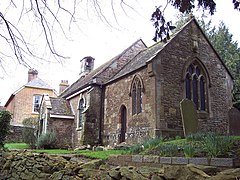Fifehead Neville
| Fifehead Neville | |
|---|---|
 All Saints Church |
|
| Fifehead Neville shown within Dorset | |
| Population | 147 |
| OS grid reference | ST766109 |
| District | |
| Shire county | |
| Region | |
| Country | England |
| Sovereign state | United Kingdom |
| Police | Dorset |
| Fire | Dorset and Wiltshire |
| Ambulance | South Western |
| EU Parliament | South West England |
Fifehead Neville is a village and civil parish in the county of Dorset in southern England, situated in the Blackmore Vale about 2 miles (3.2 km) southwest of the town of Sturminster Newton in the North Dorset administrative district. In the 2011 census the population of the parish was 147.
The first part of the name Fifehead Neville derives from the Old English fīf and hīd, meaning '(estate of) five hides of land'. It was recorded as Fifhide in the Domesday Book of 1086. The second part derives from the de Neville family who were here in the 13th century; in 1287 the name Fyfhud Neuyle was recorded. This differentiated this Fifehead from other Dorset manorial holdings called Fifehead (Fifehead St Quintin and Fifehead St Magdalen).
In a field bordering the River Divelish the remains of two wings of a Roman villa were found in 1880 and 1903. Floor mosaics and part of a hypocaust system were uncovered. The archaeological findings are on view in the Dorset County Museum in Dorchester.
The Domesday Book records that in 1086 the estate of Fifehead Neville had eight households and was part of Pimperne Hundred. The tenant-in-chief of the estate was Waleran the Hunter whose tenant was Ingelrann. The overlordship descended to Walter Walerand (d. 1200–1) and to his daughter and co-heiress Isabel de Waleran who married William de Nevill. The overlordship was inherited by Isabel de Nevill's daughter Joan de Nevill (d. 1263), wife of Jordan de St. Martin.
Crossing the Divelish is an old packhorse bridge that has two pointed arches and is probably medieval.
Before 1920 the parish was in two parts, each with its own settlement—Fifehead Neville in the north and Lower Fifehead or Fifehead St Quentin in the south. It is probable each settlement had previously had its own open field system. Fifehead St Quentin (or Fifehead St Quintin) was previously a detached part of Belchalwell, a former parish that is now part of the parish of Okeford Fitzpaine.
...
Wikipedia

